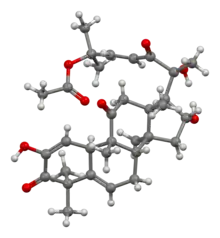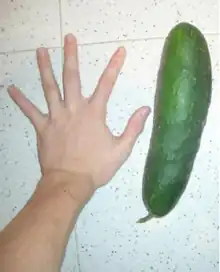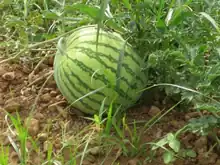 | |
 | |
| Names | |
|---|---|
| IUPAC name
(23E)-2,16α,20-Trihydroxy-3,11,22-trioxo-19-nor-9β,10α-lanosta-1,5,23-dien-25-yl acetate | |
| Systematic IUPAC name
(3E,6R)-6-[(1R,2R,3aS,3bS,9aR,9bR,11aR)-2,8-Dihydroxy-3a,6,6,9b,11a-pentamethyl-7,10-dioxo-2,3,3a,3b,4,6,7,9a,9b,10,11,11a-dodecahydro-1H-cyclopenta[a]phenanthren-1-yl]-2-methyl-5-oxohept-3-en-2-yl acetate | |
| Identifiers | |
3D model (JSmol) |
|
| ChemSpider | |
| ECHA InfoCard | 100.038.463 |
PubChem CID |
|
| UNII | |
| |
| |
| Properties | |
| C32H44O8 | |
| Molar mass | 556.696 g·mol−1 |
| Density | 1.249 g/cm3 |
| Melting point | 228 to 232 °C; 442 to 449 °F; 501 to 505 K |
Except where otherwise noted, data are given for materials in their standard state (at 25 °C [77 °F], 100 kPa).
Infobox references | |
Cucurbitacin E is a biochemical compound from the family of cucurbitacins. These are found in plants which are member of the family Cucurbitaceae, most of them coming from traditional Chinese medicinal plants, but also in other plants such as pumpkins and gourds.
Cucurbitacin E is a highly oxidated steroid consisting of a tetracyclic triterpene. Specific modifications in this molecule under certain conditions can form other types of cucurbitacins such as cucurbitacin I, J, K and L.
As of 2020, it is being investigated for its potential biological effects. Cucurbitacin E has been found to increase activity of anti-cancer drugs in certain types of cancers.[1] It selectively increases chemosensitivity of nutrient receptors, on or inside cancer cells, to anti-cancer drug molecules, thereby decreasing binding of the nutrients to cancer cells, and decreasing their growth, leading to selective cell death of cancer cells.[1]


Research
Anti-inflammatory
Cucurbitacin E anti-inflammatory activities are proved in vivo and in vitro. It is useful in the treatment of inflammation because of the inhibition of cyclooxygenase and reactive nitrogen species (RNS) but not reactive oxygen species (ROS).
Macrophages are responsible for the production of various cytokines, RNS and ROS, growth factors and chemokines as a response to activation signal such as chemical mediators, cytokines and lipopolysaccharide. Although these molecules have an important role, they can also have damaging effects, like some RNS. Cucurbitacin possesses dose-dependent anti-inflammatory activity related to its inhibition of nitric oxide (an RNS) production in macrophages without affecting the viability of these cells.
As cucurbitacin E doesn't affect normal human liver cells, it may have therapeutic potential and effective treatment for a variety of inflammation mediated diseases.[2]
Antioxidant
Cucurbitacin E glycoside has demonstrated antioxidant and free-radical scavenging properties. Its antioxidant and free-radical scavenging properties were measured by the ability of cucurbitacin glycoside combination (CGC), a combination of cucurbitacin B and E glycosides, to reduce ABTS cation to its original form and also the capacity to inhibit MDA formation originated in the oxidation of linoleic acid. Using electron paramagnetic resonance, it was confirmed that CGC had antioxidant properties because of its capacity for scavenging free radicals, such as: superoxide anion (O2-), hydroxyl radical (OH-) and singlet oxygen. Not all natural antioxidants have strong free-radical scavenging properties against multiple free-radicals.[3]
CGC is being investigated as a treatment for human diseases that are linked to oxidative or free-radical damage such as atherosclerosis, cancer, Alzheimer's disease and diabetes.[4]
Cytostatic
Cucurbitacin E is an inhibitor during the S to M phase in the cell mitosis. It causes a reduction of cell multiplication.
Cytotoxicity
This triterpene can inhibit the phosphorylation of the cofilin protein, a family of actin-binding proteins that disassembles actin filaments.[5][6]
Cucurbitacin E shows cytotoxicity to:[7]
- The colon cancer cell line HCT-116
- The lung cancer cell line NCI-H460
- The breast cancer cell lines MCF-7 and ZR-75-1
- The central nervous system tumor cell line SF-268
- The oral epidermoid carcinoma cell line KB
- The cervical cancer cell line HeLa
- The fibrosarcoma cell line HT1080
- The acute leukemia cell lines U937 and HL-60
- The prostate cancer cell lines PC, LNCaP and DU145
- The pancreatic cancer cell line Panc-1
- The ovarian cancer cell line S-2
- The bladder cancer cell line T24
- The hepatic carcinoma cell lines BEL-7402 and HepG2
Anti-angiogenesis
Cucurbitacin can also inhibit VEGFR2-mediated Jak-STAT3[7] and MAPK signaling pathways. Anti-angiogenesis property of cucurbitacin E was demonstrated in vitro but also in vivo in a chick embryo chorioallantoic membrane and in a mouse corneal angiogenesis model.
Anti-invasion and anti-metastasis
In vitro, cucurbitacin E inhibits the adhesion of cancer cells in type I collagen.[7]
Hepatoprotecive effect
In vitro, cucurbitacin E protects hepatocytes from CCl4 (carbon tetrachloride), by reducing GPT, GOT, ALP, TP and TBIL serums.[7]
Insecticide
Curcurbitacin E has insecticidal effects against the aphid Aphis craccivora.[8]
See also
References
- 1 2 Yang, Peng; Liu, Wen; Fu, Rong; Ding, Guo-bin; Amin, Sajid; Li, Zhuoyu (2020-12-02). "Cucurbitacin E Chemosensitizes Colorectal Cancer Cells via Mitigating TFAP4/Wnt/β-Catenin Signaling". Journal of Agricultural and Food Chemistry. 68 (48): 14148–14160. doi:10.1021/acs.jafc.0c05551. ISSN 0021-8561. PMID 33205649. S2CID 227038679.
- ↑ Abdelwahab, S. I.; Hassan, L. E. A.; Sirat, H. M.; Yagi, S. M. A.; Koko, W. S.; Mohan, S.; Taha, M. M. E.; Ahmad, S.; Chuen, C. S.; Narrima, P.; Rais, M. M.; Hadi, A. H. A. (2011). "Anti-inflammatory activities of cucurbitacin E isolated from Citrullus lanatus var. Citroides: Role of reactive nitrogen species and cyclooxygenase enzyme inhibition". Fitoterapia. 82 (8): 1190–1197. doi:10.1016/j.fitote.2011.08.002. PMID 21871542.
- ↑ Tannin-Spitz, T.; Bergman, M.; Grossman, S. (2007). "Cucurbitacin glucosides: Antioxidant and free-radical scavenging activities". Biochemical and Biophysical Research Communications. 364 (1): 181–186. doi:10.1016/j.bbrc.2007.09.075. PMID 17942079.
- ↑ Clancy, D.; Birdsall, J. (2012). "Flies, worms and the Free Radical Theory of ageing". Ageing Research Reviews. 12 (1): 404–12. doi:10.1016/j.arr.2012.03.011. PMID 22504404. S2CID 23139852.
- ↑ Drubin, D. G.; Lappalainen, P. (1997). "Cofilin promotes rapid actin filament turnover in vivo". Nature. 388 (6637): 78–82. Bibcode:1997Natur.388R..78L. doi:10.1038/40418. PMID 9214506. S2CID 205027806.
- ↑ Nakashima, S.; Matsuda, H.; Kurume, A.; Oda, Y.; Nakamura, S.; Yamashita, M.; Yoshikawa, M. (2010). "Cucurbitacin E as a new inhibitor of cofilin phosphorylation in human leukemia U937 cells". Bioorganic & Medicinal Chemistry Letters. 20 (9): 2994–2997. doi:10.1016/j.bmcl.2010.02.062. PMID 20347305.
- 1 2 3 4 Chen, X.; Bao, J.; Guo, J.; Ding, Q.; Lu, J.; Huang, M.; Wang, Y. (2012). "Biological activities and potential molecular targets of cucurbitacins". Anti-Cancer Drugs. 23 (8): 777–787. doi:10.1097/CAD.0b013e3283541384. PMID 22561419. S2CID 30016950.
- ↑ Torkey, H.M., Abou-Yousef, H.M., Abdel Azeiz, A.Z. and Hoda, E.A. Farid. Insecticidal Effect of Cucurbitacin E Glycoside Isolated from Citrullus colocynthis Against Aphis craccivora. Australian Journal of Basic and Applied Sciences 2009; 3(4): 4060-4066
External links
Further reading
- Attard, E.; Brincat, M. P.; Cuschieri, A. (2005). "Immunomodulatory activity of cucurbitacin E isolated from Ecballium elaterium". Fitoterapia. 76 (5): 439–441. doi:10.1016/j.fitote.2005.02.007. PMID 15908139.
- Dong, Y.; Lu, B.; Zhang, X.; Zhang, J.; Lai, L.; Li, D.; Wu, Y.; Song, Y.; Luo, J.; Pang, X.; Yi, Z.; Liu, M. (2010). "Cucurbitacin E, a tetracyclic triterpenes compound from Chinese medicine, inhibits tumor angiogenesis through VEGFR2-mediated Jak2-STAT3 signaling pathway". Carcinogenesis. 31 (12): 2097–2104. doi:10.1093/carcin/bgq167. PMID 20732905.
- Navolokin, NA; Polukonova, NV; Maslyakova, GN; Bucharskaya, AB; Durnova, NA (2012). "Effect of extracts of Gratiola officinalis and Zea mays on the tumor and the morphology of the internal organs of rats with transplanted liver cancer". Russian Open Medical Journal. 1 (2): 0203. doi:10.15275/rusomj.2012.0203.